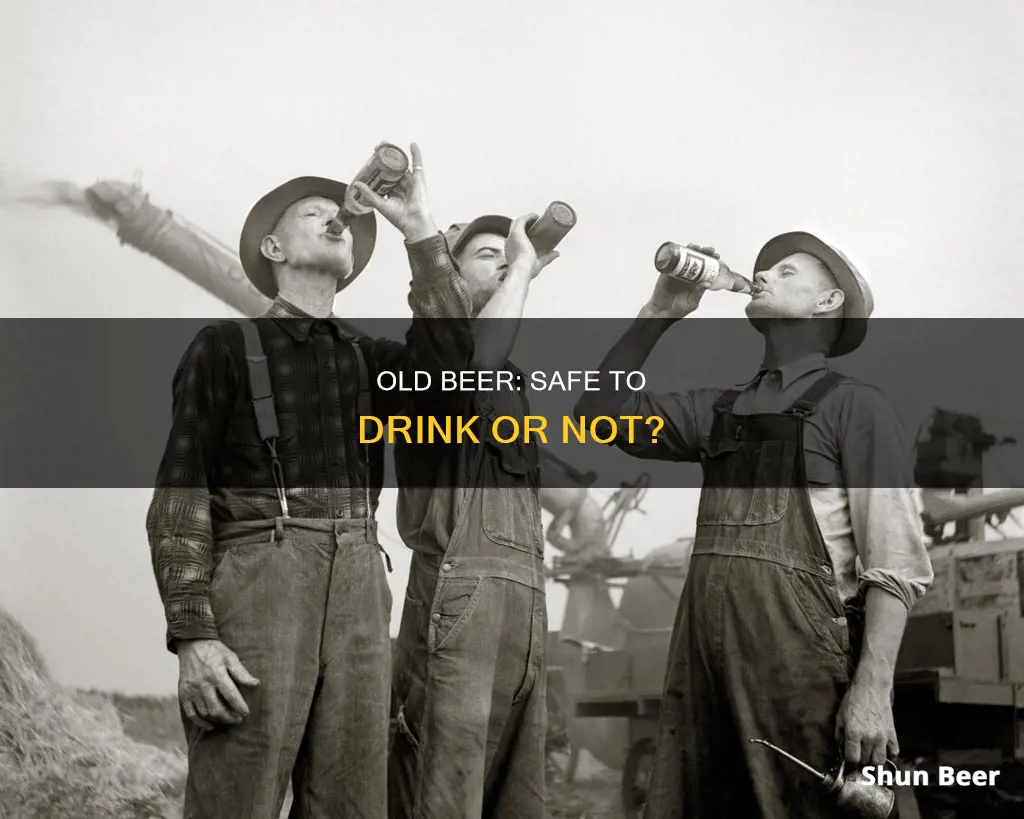
Beer typically has a best before date rather than a use by date, which means that it is still safe to drink after this date but the quality may start to deteriorate. While some beers can improve with age, like richer and higher ABV beers such as porters and stouts, others – especially IPAs – lose their flavour and aroma over time. The fermentation process, low pH level and alcohol content of beer mean that it is an unfriendly environment for microorganisms, so even if a beer sits on the shelf for years it is unlikely to make you sick. However, the taste of beer does change over time, and oxygen, heat and light can cause flavours to go awry.
What You'll Learn

Beer's ''best before' date is a guideline on quality, not safety
Beer typically has a 'best before' date rather than a 'use by' date. This is an important distinction as 'use by' dates are more of a rule, with food and drink quickly becoming unsafe to consume after the stated date. 'Best before' dates, on the other hand, are more of a guideline on quality than safety. This means that beer will start to lose its quality after the stated date but can still be consumed.
The shelf life of beer varies depending on the type of beer and how it is stored. A typical lager will be drinkable 6–24 months after its best before date if it has been kept in a fridge, and up to 9 months if it hasn't been refrigerated. However, IPAs are best drunk within 4 months of their packaging date as they gradually lose their flavour and aroma over time.
Some beers, like wine and whiskey, can improve with age. Richer and higher ABV varieties such as porters and stouts can get better if they're kept in cool, dark storage conditions like a basement or cellar.
While drinking beer past its best before date is generally safe, the taste of the beer will change over time. Beer that is years past its best before date may taste overly sweet, sour, or develop a skunky flavour.
A Risky Mix: Beer and Benzonatate
You may want to see also

Beer can be stored for years if sealed
Beer is a delicate beverage, and its enemies are oxygen, heat, and light. Oxygen interacts with the compounds from malt, yeast, and hops, causing oxidation and a papery taste. Heat speeds up oxidation, and major temperature changes can also negatively impact the flavour of beer. Lastly, light—especially UV light—can cause a chemical reaction in hop compounds, resulting in an unpleasant skunky taste.
Despite this, beer can be stored for years if sealed, due to the fermentation process used in brewing, as well as its low pH level and alcohol content, which make it difficult for microorganisms to grow. However, the taste of the beer will change over time, and it is recommended to drink beer as fresh as possible.
To maintain the freshness of beer, it is important to store it in a cool, dark place, preferably a refrigerator. If storing at room temperature, ensure that the beer is not exposed to sunlight. It is also recommended to store bottles upright to minimise exposure to oxygen.
Different styles of beer will have different shelf lives. High-alcohol, malt-forward styles, such as barley wines and imperial stouts, are sometimes brewed with aging in mind and can improve with age, especially when stored in cool, dark conditions. On the other hand, IPAs, especially hoppy ones, gradually lose their flavour and aroma over time and are best consumed fresh.
Beer and Kidney Health: What's the Connection?
You may want to see also

Beer should be stored in a cool, dark place
Beer is best stored in a cool, dark place. This is because beer is susceptible to deterioration caused by heat, light, and oxygen.
Firstly, beer should be stored in a cool place. Heat will accelerate the chemical reactions that cause beer to break down and spoil. The higher the temperature, the faster the beer will age. Fluctuations in temperature are not ideal, but re-chilling a beer that has been previously refrigerated will not significantly impact its quality. It is also important to note that beer should not be frozen, as this will cause the proteins within the beer to denature, changing the molecular structure and resulting in a haze, known as "chill haze" or "beer haze".
Secondly, beer should be stored in a dark place. Beer is often sold in dark bottles to protect the liquid from the sun's UV rays. Exposure to sunlight can cause a chemical reaction in the beer, breaking down its flavour components until the beverage smells and tastes like skunk spray. This is known as "skunking" or "lightstrike". Even fluorescent light can accelerate a beer's best-before date, so refrigeration is always preferable to room temperature.
Finally, beer should be stored in an upright position to minimise the surface area of liquid that comes into contact with the air inside the bottle. This slows the rate of oxidation, which will cause the beer to become flat.
Jacksonville Beach: Beer Drinking Rules and Regulations
You may want to see also

Beer's flavour changes over time, and it can become vinegary
Beer is produced with expiry dates, but these are more of a guideline on quality than safety. The fermentation process used in brewing beer, as well as its low pH level and alcohol content, make beer an unfriendly environment for microorganisms. Therefore, even if a beer sits on the shelf for years, as long as it’s sealed, it’s unlikely to make you sick.
However, the flavour of beer changes over time, and what was once refreshing could become a real stinker. Beers past their prime can taste like wet cardboard, overly sweet, or skunky. The latter is caused by exposure to UV light, which triggers a chemical reaction in the hops that gives off an unpleasant skunky taste.
If a beer that isn’t supposed to be tangy or acidic has a vinegary taste, it’s a sign that bacteria have gotten in, and you’ll need to toss it out.
Oxygen, heat, and light are the main culprits that can cause flavours to go awry. Oxygen interacts with the compounds from malt, yeast, and hops, causing oxidation and a disappointing papery taste. Heat speeds up oxidation, so storing beer in a refrigerator is recommended. Major changes in temperature can also negatively impact the flavour of beer, and sadly, this can’t be reversed.
To prevent off flavours, keep beer in a cool, dark place, preferably the refrigerator. If storing at room temperature, ensure that the beer is not exposed to sunlight.
Coffee and Beer: A Match Made in Heaven?
You may want to see also

Higher alcohol content beers have greater longevity
Beer typically has a best-before date, which is a guideline on quality rather than safety. This means that the beer will start to lose its quality after the stated date but can still be consumed. Beer typically has a shelf life of a few months to a year, but some beers can be aged and will improve with age.
Beers with higher alcohol content tend to have greater longevity. The higher alcohol content inhibits bacterial growth, preventing the beer from becoming unsafe to drink. The alcohol acts as a preservative, allowing the beer to be stored for longer periods without spoilage. Additionally, the brewing process and ingredients used can also contribute to the longevity of higher alcohol content beers.
For example, barley wines and imperial stouts are designed to be aged and can develop complex and profound flavours over time. The high alcohol content in these beers allows them to be stored for extended periods, giving the various compounds time to break down and create new flavours. The slow oxidation and breakdown of compounds in these beers contribute to their longevity, as they continuously evolve and develop new flavours over time.
The aging process for beers with higher alcohol content can enhance and deepen their flavours. The interactions between the various compounds in the beer, such as the microflora in lambic beers, can lead to unique and desirable flavour profiles. The aging process can also reduce the bitterness and aroma of hops, which is desirable for certain beer styles.
Proper storage conditions are crucial for maximizing the longevity of higher alcohol content beers. Similar to wine, these beers are best stored at "cellar temperatures" of approximately 11°C to 13°C (52°F to 55°F). Storing the bottles upright and in a dark place can also help maintain their quality over time.
Beer and Azithromycin: Is It Safe to Mix?
You may want to see also
Frequently asked questions
Yes, you can. The fermentation process used in brewing, as well as its low pH level and alcohol content, make beer an unfriendly environment for microorganisms. Even if a beer sits on the shelf for years, as long as it's sealed, it's unlikely to make you sick.
It should be fairly obvious from the bad aroma, but also, if it's missing the usual fizz and foaming at the top when you open it, it's likely gone bad. You could also look at the bottom of the bottle for excessive sediment, which could contribute to a poor taste.
It depends on the type of beer and how it's stored. A typical lager will be drinkable 6-24 months after its best-before date if it's been kept in the fridge. That timeframe tops out at 9 months if it hasn't been refrigerated. Some beers, like porters and stouts, can improve with age if kept in cool, dark storage.
To make your beer last longer, store it in a cool, dark place, preferably the refrigerator. If you're storing at room temperature, keep it out of direct sunlight. Also, leave the beers standing upright to reduce exposure to oxygen.







